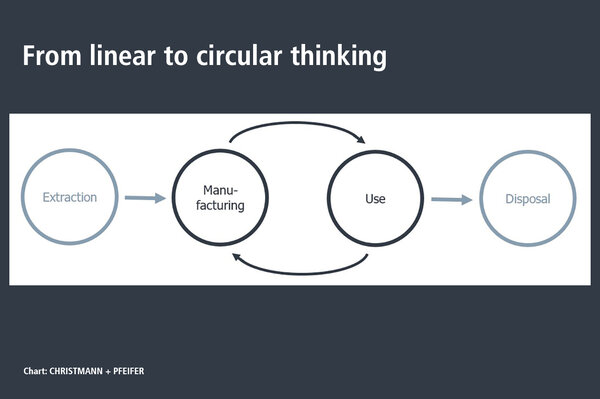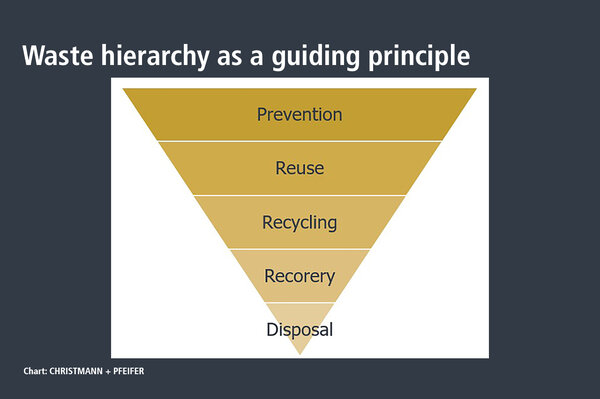
Building the future.
With circular economy and modular systems.

Our world is facing huge challenges: resources are becoming scarcer, and at the same time, the demand for residential and commercial space is growing. Creating ecological and economical solutions requires a rethink in planning and building. We at CHRISTMANN + PFEIFER are breaking new ground – with circular economy and innovative modular construction systems.
From linear to circular thinking
The traditional construction industry usually follows a linear principle. Raw materials are extracted, processed, used, and finally disposed of. This puts a strain on the environment and climate and causes high resource consumption.
The circular economy on the other hand aims to extend the materials’ life cycle. Raw materials should be kept in circulation for as long as possible through reuse, repair, repurposing, or high-quality recycling. That means: less waste, less resource consumption, more sustainability.
The principle behind that is “cradle to cradle” – an approach in which products are designed that their materials can be completely recycled or reused without loss of quality at the end of their life cycle.
Waste Hierarchy as a guiding principle
The central part of the circular economy is the so-called waste hierarchy. It specifies how materials should be handled after use, prioritizing options from the most environmentally friendly to the least sustainable.
The focus is clearly on prevention and reuse, because even recycling, for example by melting down material, involves energy consumption and emissions. This is why we at C + P specifically develop building systems that can be reused multiple times without great effort.
Steel - robust, durable, recyclable
Steel is an important material for us, and it is ideal for circular economy. It can be recycled almost indefinitely without losing quality. But here too: reuse is better than melting down.
Modular construction - flexible, efficient, reusable
Modular construction is a particularly future-proof approach to sustainable construction. This involves constructing buildings from prefabricated three-dimensional modules that are assembled quickly and precisely on the construction site. Precise planning of material consumption conserves resources and reduces waste.
Preflex® Parkhaus
With our Preflex® Parkhaus, we implement the principles of circular economy and of modular construction: the parking garages are prefabricated as standard in our factory, can be erected in a short time, and can be dismantled without damage and reassembled elsewhere if needed.
The parking garages can be extended, reduced, or used temporarily when required. This results in solutions that are not only efficient and economical, but also sustainable and future-proof.
Modular Construction by C + P
We also focus on maximum efficiency and high sustainability in modular construction. Our buildings consist of industrially prefabricated modules that are assembled on site in a very short time. This results in modern, flexible buildings with many advantages:
- Shorter construction period
- Minimal impact on residents and environment
- Easy dismantling: modules can be taken apart and reused at a new location
- Ideal for temporary solutions
Together for a sustainable future
We at C + P believe: those who build today carry the responsibility for tomorrow. That is why we are developing concepts that link ecological, economic, and social sustainability. With our construction systems, we have a clear focus on circular economy and reuse.
We want to build a future that is flexible, modular and sustainable.


